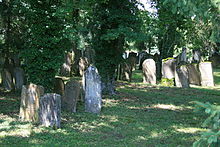Endingen Jewish cemetery
The Endingen Jewish Cemetery is located in the municipality of Endingen in the canton of Aargau . It is the oldest still existing Jewish cemetery in Switzerland . Since 1963, the cemetery stands as a cultural asset of national importance under conservation .
history
Until 1750, the Jews of Switzerland had to bury their dead on the small Jewish column island in the Rhine near Koblenz AG . Repeated floods flooded the island and caused damage to the graves. The Jews living in the Surbtal villages of Endingen and Lengnau successfully applied for permission from the federal locations to build a new cemetery in Endinger municipality near the border with Lengnau. The purchase price for the land on the road between the two villages was 340 guilders .
Due to the population growth, the cemetery had to be expanded towards the west at the end of the 18th century. Further expansions towards the west took place in the 19th and 20th centuries. According to a contractual agreement from 1859, two fifths of the cemetery property belonged to the Israelite community of Lengnau and three fifths to the Israelite community of Endingen. Since 1920 the "Association for the Preservation of Synagogues and the Endingen-Lengnau Cemetery" has been responsible for the maintenance and care of the burial places. The last existing graves on the Jewish column were closed in 1954 and the dead were reburied here.
On July 14, 2010, the cemetery suffered storm damage, but it was largely eliminated. An uprooted beech tree had lifted half a dozen tombstones out of the row of graves with its root funnel. The old tombstones, which were partially grown into the tree trunk and its roots, are again in line with the neighboring graves. According to the inventory, the graves concerned are among the oldest in the entire cemetery: the burials took place in 1789/90.
investment
The graves are arranged in a north-south direction, with women and men buried separately. In Jewish cemeteries, the dead are usually buried with their feet facing east. It is not known why the alignment is different here.
The oldest part of the cemetery is located directly on the country road. In this area, the tombstones appear uniform, as at that time the basic shape of the ancient stele was only deviated in nuances. Most were made of Endinger sandstone , those of the more affluent families from weather-resistant Mägenwil shell limestone .
From the middle of the 19th century, in addition to the previously common Hebrew grave inscriptions, those in German with Latin letters were also published. The buried were increasingly given tombstones in the classical style and with neo-Gothic shapes, and there were also broken columns for the young dead and obelisks . Marble was increasingly used . After the Second World War , in keeping with the spirit of the times, simple and uniform gravestone shapes came into their own again. The inscriptions were again limited to the bare essentials and some were in Hebrew.
See also
literature
- Edith Hunziker, Ralph Weingarten: The synagogues of Lengnau and Endingen and the Jewish cemetery . Ed .: Society for Swiss Art History. Swiss art guide, volume 771/772 , series 78.Bern 2005, ISBN 3-85782-771-8 .
- Judenfriedhof Endingen-Lengnau, Endingen 1993, four volumes, ISBN 3-9520180-1-5
- Anna Rapp Buri: Jewish cultural assets in and from Endingen and Lengau . regional culture publisher, Ubstadt-Weiher 2008, ISBN 978-3-89735-493-7 .
Web links
- Jewish cemetery in Endingen on www.alemannia-judaica.de
- Endingen Jewish cemetery in the inventory of the canton of Aargau
- Endingen Jewish Cemetery In: E-Periodica
Coordinates: 47 ° 31 '58.5 " N , 8 ° 18' 32" E ; CH1903: 665530 / 265050



